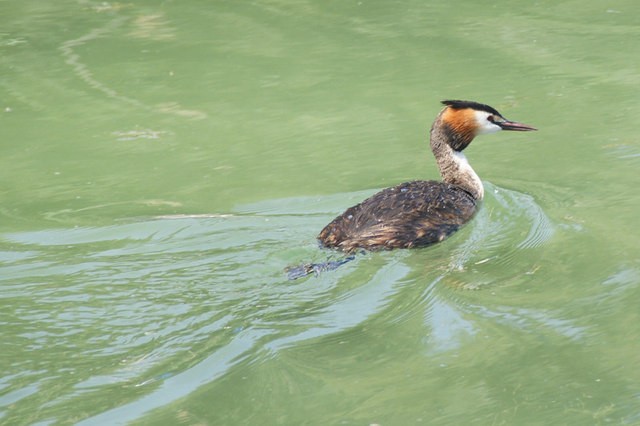Great Crested Grebe
A species of Typical Grebes Scientific name : Podiceps cristatus Genus : Typical Grebes
Great Crested Grebe, A species of Typical Grebes
Botanical name: Podiceps cristatus
Genus: Typical Grebes
Content
Description People often ask General Info
 Photo By Mike Pennington on geo.hlipp.de , used under CC-BY-SA-2.0 /Cropped and compressed from original
Photo By Mike Pennington on geo.hlipp.de , used under CC-BY-SA-2.0 /Cropped and compressed from original Description
Look for great Crested Grebe in areas with plenty of reeds. This water bird uses the reeds to build floating nests on rivers, lakes, and reservoirs. While the bird joins flocks in the winter, it is territorial. Breeding pairs will defend the area around their nest. The bird forages for insects, small fish, and other aquatic life along the shore.
Size
61 cm
Life Expectancy
10 years
Nest Placement
Floating
Feeding Habits
Great Crested Grebe primarily feeds on fish, supplemented by amphibians, insects, mollusks, and crustaceans. It dives to hunt underwater, displaying specialized adaptations for such feeding techniques. Its diet reflects a carnivorous preference for aquatic prey.
Habitat
Great Crested Grebe resides predominantly in temperate aquatic environments, adapting to a range of conditions from fresh and brackish waters to marine settings. Ideal habitats include vegetated lakes, ponds, and artificial waterbodies, which support breeding. They forage in open waters and during non-breeding periods, favor shallow inshore over deep offshore areas across estuaries, coasts, and large lakes.
Dite type
Piscivorous
People often ask
General Info
Feeding Habits
Bird food type
Behavior
The great crested grebe has an elaborate mating display. Like all grebes, it nests on the water's edge, since its legs are set relatively far back and it is thus unable to walk very well. Usually two eggs are laid, and the fluffy, striped young grebes are often carried on the adult's back. In a clutch of two or more hatchlings, male and female grebes will each identify their 'favourites', which they alone will care for and teach. 
Distribution Area
The subspecies P. c. cristatus is found across Europe and east across the Palearctic. It is resident in the milder west of its range, but migrates from the colder regions. It winters on freshwater lakes and reservoirs or the coast. The African subspecies P. c. infuscatus and the Australasian subspecies P. c. australis are mainly sedentary. 
Species Status
Not globally threatened.

 Photo By Mike Pennington on geo.hlipp.de , used under CC-BY-SA-2.0 /Cropped and compressed from original
Photo By Mike Pennington on geo.hlipp.de , used under CC-BY-SA-2.0 /Cropped and compressed from original Scientific Classification
Phylum
Chordates Class
Birds Order
Grebes Family
Grebes Genus
Typical Grebes Species
Great Crested Grebe